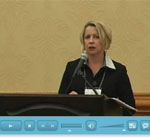Halifax Job Search Strategies Forum Report
Real Life, Real Jobs, Right Here
| Video |
 |
Janice Reynolds, Senior Human Resources Consultant, Halifax Regional Municipality
The Halifax Regional Municipality (HRM) currently employs 6,000 workers in full- and part-time positions, some of which are summer and term positions.
“HRM has a lot of diversity on offer,” said Janis Reynolds. It has offices downtown, in Dartmouth, Sackville, and the West End Mall, with locations including recreation sites and fire departments.
The municipality offers career and development opportunities in house, and staff are encouraged to continue their education while working. Most of the positions are unionized, with five unions in total. Those salaries are determined by collective bargaining. Non-unionized positions undergo competitive review. Reynolds said HRM stresses work-life balance. It is rewarding to work and live in the same community; she particularly enjoys seeing local projects like the building of the Armdale roundabout.
Positions within the HRM workplace vary depending on the department. The chief administrative office reports to council and oversees all of the staff and business units. A community development section oversees recreation, civic events, planning and development. The infrastructure and asset management department handles roads, buildings, and capital projects. Transport and public works handles solid waste, transit, and city vehicles. One department handles information technology, another handles finance. Other departments include fire, police, and legal.
HRM has had an employment equity policy since 1997, and has designated employment equity recruitment in all areas including police and fire departments, and accessible work locations and outreach groups. HRM encourages people to self-identify as disabled in job applications, said Reynolds.
Any positions open to the public are posted on the new HRM online recruitment system.
“We post new jobs every couple of days, so you should check back a couple of times a week,” Reynolds said. A questionnaire attached to each job posting asks about citizenship and disabilities. Rather than screening for keywords relating to the applicant’s potential qualifications as some online application systems do, HRM uses a questionnaire to screen applicants more accurately. Unlike most employers, Reynolds does not mind applicants phoning in to ask about where they are in the process or whether they have been screened in.
Reynolds encouraged participants to perform a self-assessment before applying.
“Do I have the qualifications? Do I have the knowledge HRM is looking for? Would I enjoy those duties? Is the location accessible by bus, or do I need a car? Does the position involve heavy lifting?”
The resumé is the most important part of an application, said Reynolds.
“The resumé is the first impression you are making to an organization; it’s a marketing tool used to assess qualifications.” If HRM asks for a specific skill or knowledge base, applicants possessing that qualification should list it in their resumés. Customize the cover letter and resumé to the specific position, and make the cover letter highlight the resumé.
“Don’t refer to ‘company’ if the organization isn’t one,” Reynolds said, noting HRM gets many cover letters describing the municipality as such.
Applicants should start preparing for an interview at the time of application, as they might not be given much notice. That might mean confirming the exact location by going there a day ahead of time. HRM interviews consist of behavioral event questions addressing “a time when,” as well as questions about customer service, analytic thinking, and diversity.
“Applicants should know the job description and anticipate any questions we may ask.”
Reynolds gave job seekers five tips to finding employment:
- Get the resumé right.
- Consider it a job to get a job.
- Put your best foot forward in the interview.
- Keep current on the organization.
- Check for errors.

 Quick Question:
Quick Question:

